Financial Accounting Principles Report: Case Studies and Analysis
VerifiedAdded on 2020/10/22
|21
|5839
|347
Report
AI Summary
This report provides a comprehensive overview of financial accounting principles, including their purpose and application. It begins with an introduction to financial accounting, defining its role in recording, classifying, and reporting financial transactions for internal and external stakeholders. The report then explores the purpose of financial accounting, emphasizing its significance in providing information for decision-making, assessing business performance, and ensuring compliance with regulations. It distinguishes between internal and external stakeholders, detailing their respective interests in financial information. The report further delves into practical aspects, such as journal entries, ledgers, trial balances, statements of profit and loss, and statements of financial position. It covers accounting concepts like consistency and prudence, the role of depreciation, and the differences between financial statements of sole traders and limited companies. Additionally, it explains bank reconciliation statements, control accounts, and suspense accounts, providing examples and practical applications. The report concludes with a summary of key findings and a list of references.
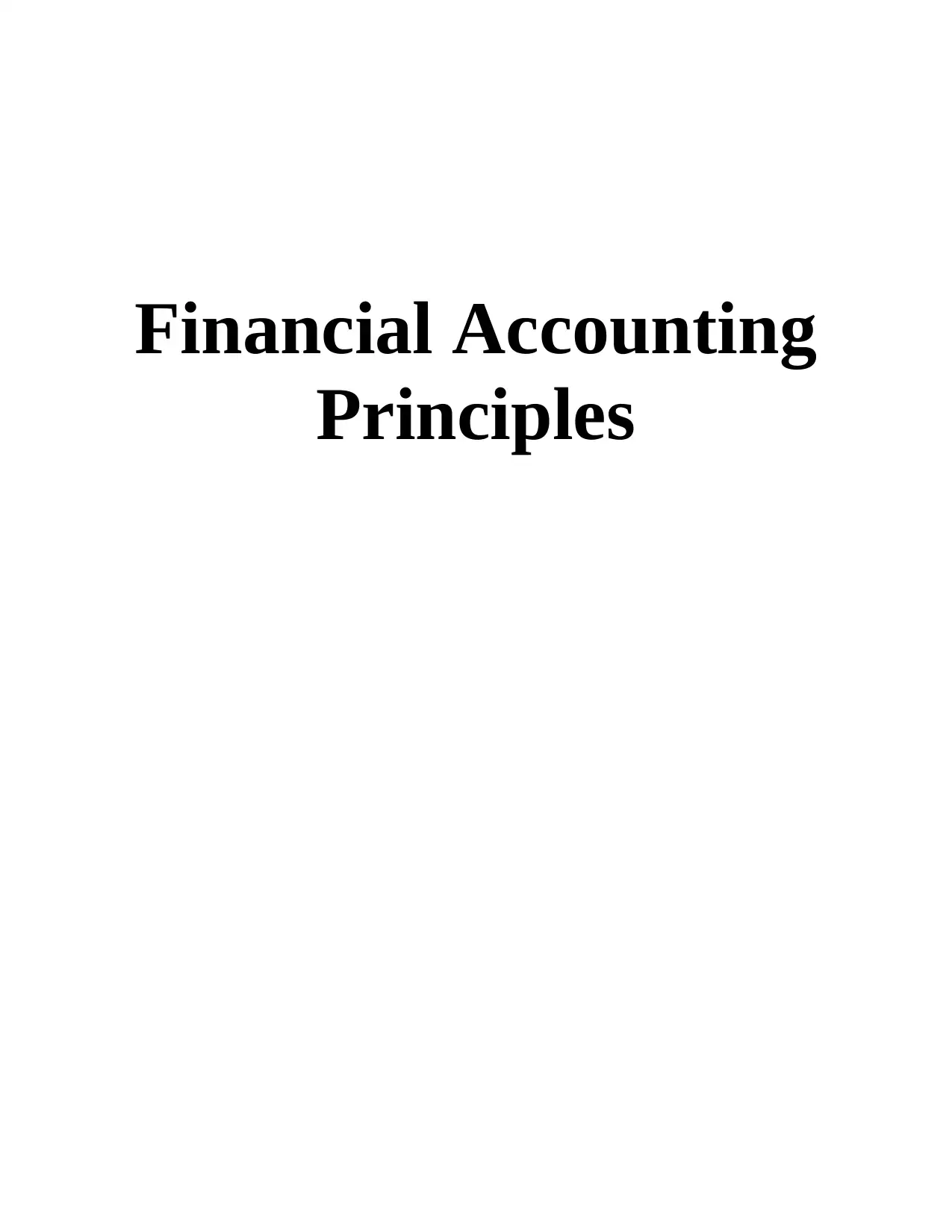
Financial Accounting
Principles
Principles
Paraphrase This Document
Need a fresh take? Get an instant paraphrase of this document with our AI Paraphraser
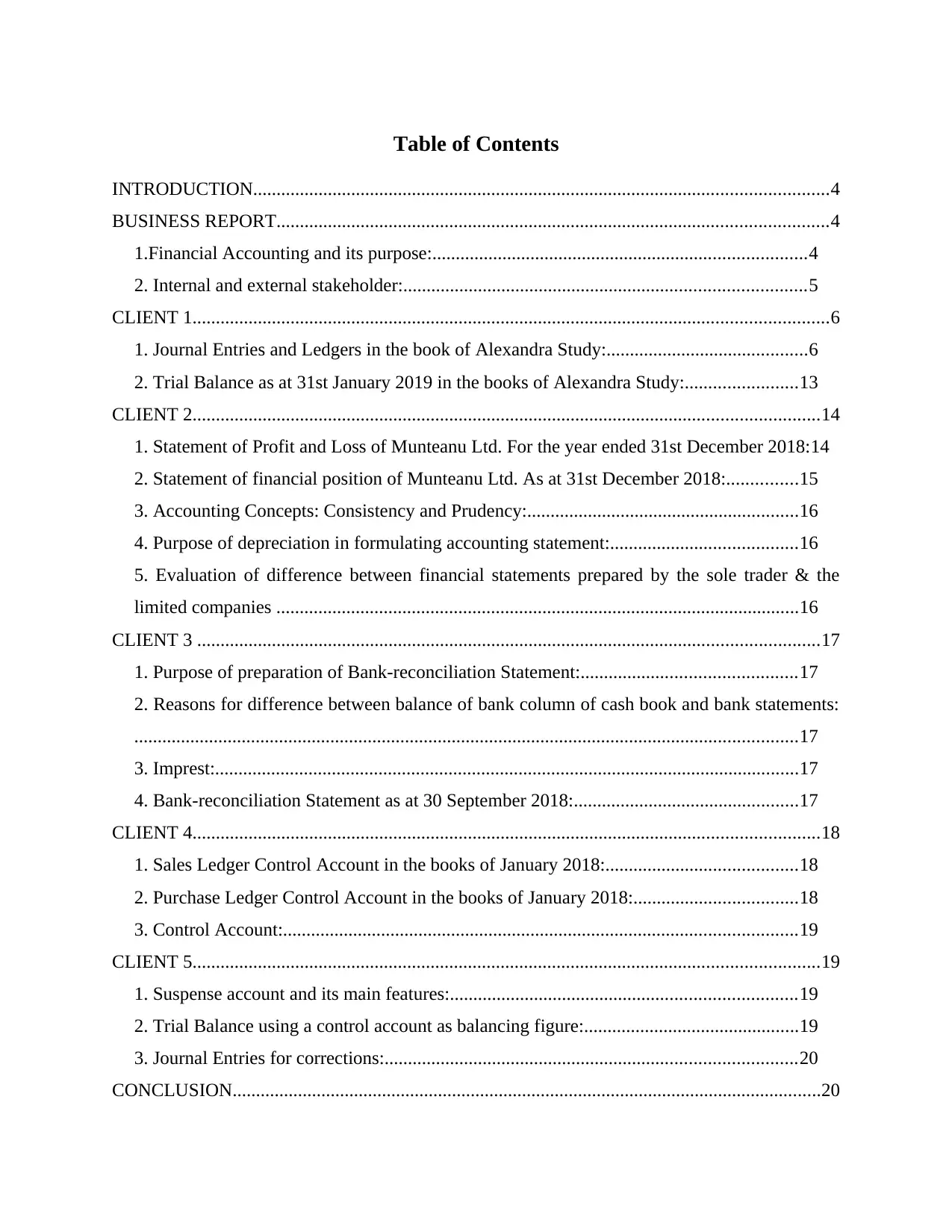
Table of Contents
INTRODUCTION...........................................................................................................................4
BUSINESS REPORT......................................................................................................................4
1.Financial Accounting and its purpose:................................................................................4
2. Internal and external stakeholder:......................................................................................5
CLIENT 1........................................................................................................................................6
1. Journal Entries and Ledgers in the book of Alexandra Study:...........................................6
2. Trial Balance as at 31st January 2019 in the books of Alexandra Study:........................13
CLIENT 2......................................................................................................................................14
1. Statement of Profit and Loss of Munteanu Ltd. For the year ended 31st December 2018:14
2. Statement of financial position of Munteanu Ltd. As at 31st December 2018:...............15
3. Accounting Concepts: Consistency and Prudency:..........................................................16
4. Purpose of depreciation in formulating accounting statement:........................................16
5. Evaluation of difference between financial statements prepared by the sole trader & the
limited companies ................................................................................................................16
CLIENT 3 .....................................................................................................................................17
1. Purpose of preparation of Bank-reconciliation Statement:..............................................17
2. Reasons for difference between balance of bank column of cash book and bank statements:
..............................................................................................................................................17
3. Imprest:.............................................................................................................................17
4. Bank-reconciliation Statement as at 30 September 2018:................................................17
CLIENT 4......................................................................................................................................18
1. Sales Ledger Control Account in the books of January 2018:.........................................18
2. Purchase Ledger Control Account in the books of January 2018:...................................18
3. Control Account:..............................................................................................................19
CLIENT 5......................................................................................................................................19
1. Suspense account and its main features:..........................................................................19
2. Trial Balance using a control account as balancing figure:..............................................19
3. Journal Entries for corrections:........................................................................................20
CONCLUSION..............................................................................................................................20
INTRODUCTION...........................................................................................................................4
BUSINESS REPORT......................................................................................................................4
1.Financial Accounting and its purpose:................................................................................4
2. Internal and external stakeholder:......................................................................................5
CLIENT 1........................................................................................................................................6
1. Journal Entries and Ledgers in the book of Alexandra Study:...........................................6
2. Trial Balance as at 31st January 2019 in the books of Alexandra Study:........................13
CLIENT 2......................................................................................................................................14
1. Statement of Profit and Loss of Munteanu Ltd. For the year ended 31st December 2018:14
2. Statement of financial position of Munteanu Ltd. As at 31st December 2018:...............15
3. Accounting Concepts: Consistency and Prudency:..........................................................16
4. Purpose of depreciation in formulating accounting statement:........................................16
5. Evaluation of difference between financial statements prepared by the sole trader & the
limited companies ................................................................................................................16
CLIENT 3 .....................................................................................................................................17
1. Purpose of preparation of Bank-reconciliation Statement:..............................................17
2. Reasons for difference between balance of bank column of cash book and bank statements:
..............................................................................................................................................17
3. Imprest:.............................................................................................................................17
4. Bank-reconciliation Statement as at 30 September 2018:................................................17
CLIENT 4......................................................................................................................................18
1. Sales Ledger Control Account in the books of January 2018:.........................................18
2. Purchase Ledger Control Account in the books of January 2018:...................................18
3. Control Account:..............................................................................................................19
CLIENT 5......................................................................................................................................19
1. Suspense account and its main features:..........................................................................19
2. Trial Balance using a control account as balancing figure:..............................................19
3. Journal Entries for corrections:........................................................................................20
CONCLUSION..............................................................................................................................20
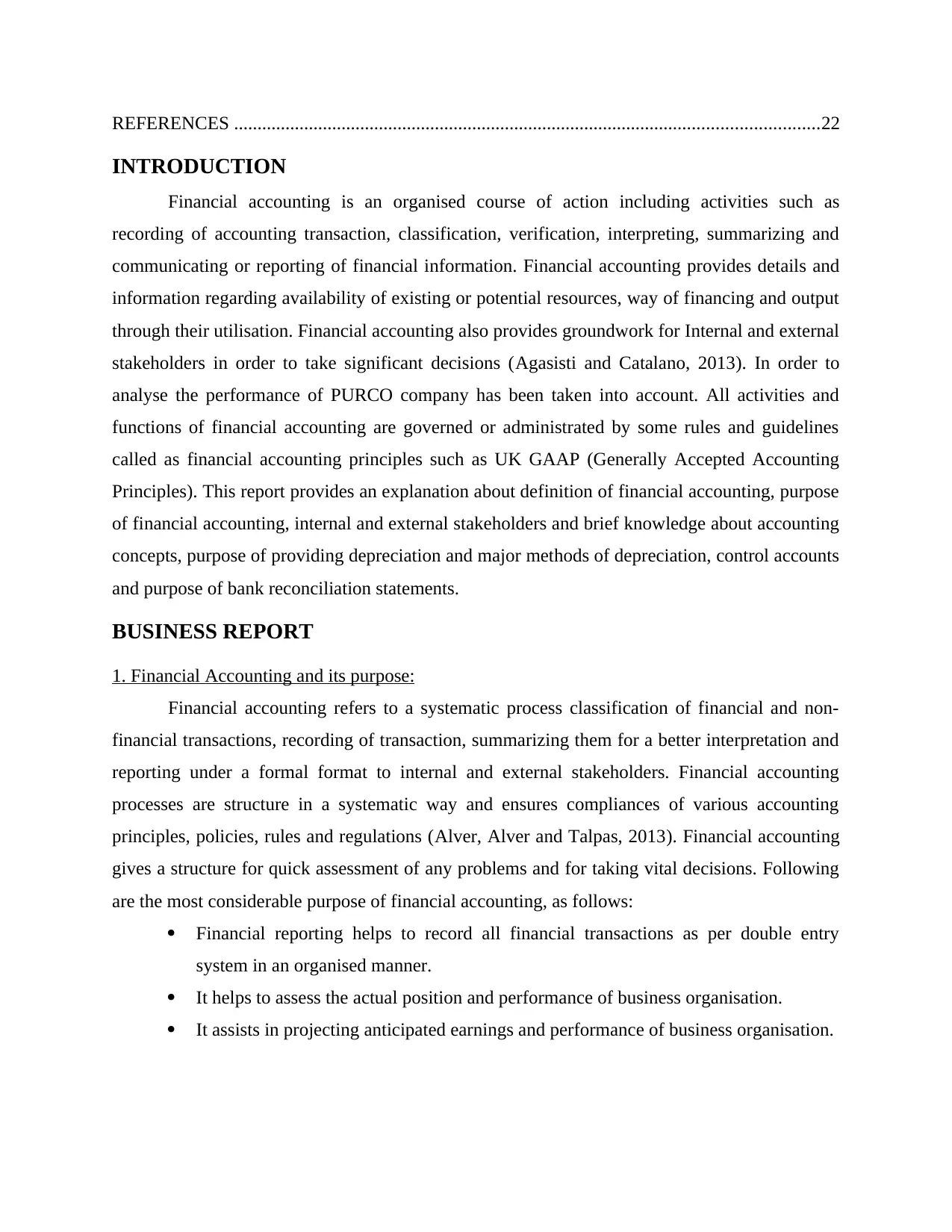
REFERENCES .............................................................................................................................22
INTRODUCTION
Financial accounting is an organised course of action including activities such as
recording of accounting transaction, classification, verification, interpreting, summarizing and
communicating or reporting of financial information. Financial accounting provides details and
information regarding availability of existing or potential resources, way of financing and output
through their utilisation. Financial accounting also provides groundwork for Internal and external
stakeholders in order to take significant decisions (Agasisti and Catalano, 2013). In order to
analyse the performance of PURCO company has been taken into account. All activities and
functions of financial accounting are governed or administrated by some rules and guidelines
called as financial accounting principles such as UK GAAP (Generally Accepted Accounting
Principles). This report provides an explanation about definition of financial accounting, purpose
of financial accounting, internal and external stakeholders and brief knowledge about accounting
concepts, purpose of providing depreciation and major methods of depreciation, control accounts
and purpose of bank reconciliation statements.
BUSINESS REPORT
1. Financial Accounting and its purpose:
Financial accounting refers to a systematic process classification of financial and non-
financial transactions, recording of transaction, summarizing them for a better interpretation and
reporting under a formal format to internal and external stakeholders. Financial accounting
processes are structure in a systematic way and ensures compliances of various accounting
principles, policies, rules and regulations (Alver, Alver and Talpas, 2013). Financial accounting
gives a structure for quick assessment of any problems and for taking vital decisions. Following
are the most considerable purpose of financial accounting, as follows:
Financial reporting helps to record all financial transactions as per double entry
system in an organised manner.
It helps to assess the actual position and performance of business organisation.
It assists in projecting anticipated earnings and performance of business organisation.
INTRODUCTION
Financial accounting is an organised course of action including activities such as
recording of accounting transaction, classification, verification, interpreting, summarizing and
communicating or reporting of financial information. Financial accounting provides details and
information regarding availability of existing or potential resources, way of financing and output
through their utilisation. Financial accounting also provides groundwork for Internal and external
stakeholders in order to take significant decisions (Agasisti and Catalano, 2013). In order to
analyse the performance of PURCO company has been taken into account. All activities and
functions of financial accounting are governed or administrated by some rules and guidelines
called as financial accounting principles such as UK GAAP (Generally Accepted Accounting
Principles). This report provides an explanation about definition of financial accounting, purpose
of financial accounting, internal and external stakeholders and brief knowledge about accounting
concepts, purpose of providing depreciation and major methods of depreciation, control accounts
and purpose of bank reconciliation statements.
BUSINESS REPORT
1. Financial Accounting and its purpose:
Financial accounting refers to a systematic process classification of financial and non-
financial transactions, recording of transaction, summarizing them for a better interpretation and
reporting under a formal format to internal and external stakeholders. Financial accounting
processes are structure in a systematic way and ensures compliances of various accounting
principles, policies, rules and regulations (Alver, Alver and Talpas, 2013). Financial accounting
gives a structure for quick assessment of any problems and for taking vital decisions. Following
are the most considerable purpose of financial accounting, as follows:
Financial reporting helps to record all financial transactions as per double entry
system in an organised manner.
It helps to assess the actual position and performance of business organisation.
It assists in projecting anticipated earnings and performance of business organisation.
⊘ This is a preview!⊘
Do you want full access?
Subscribe today to unlock all pages.

Trusted by 1+ million students worldwide
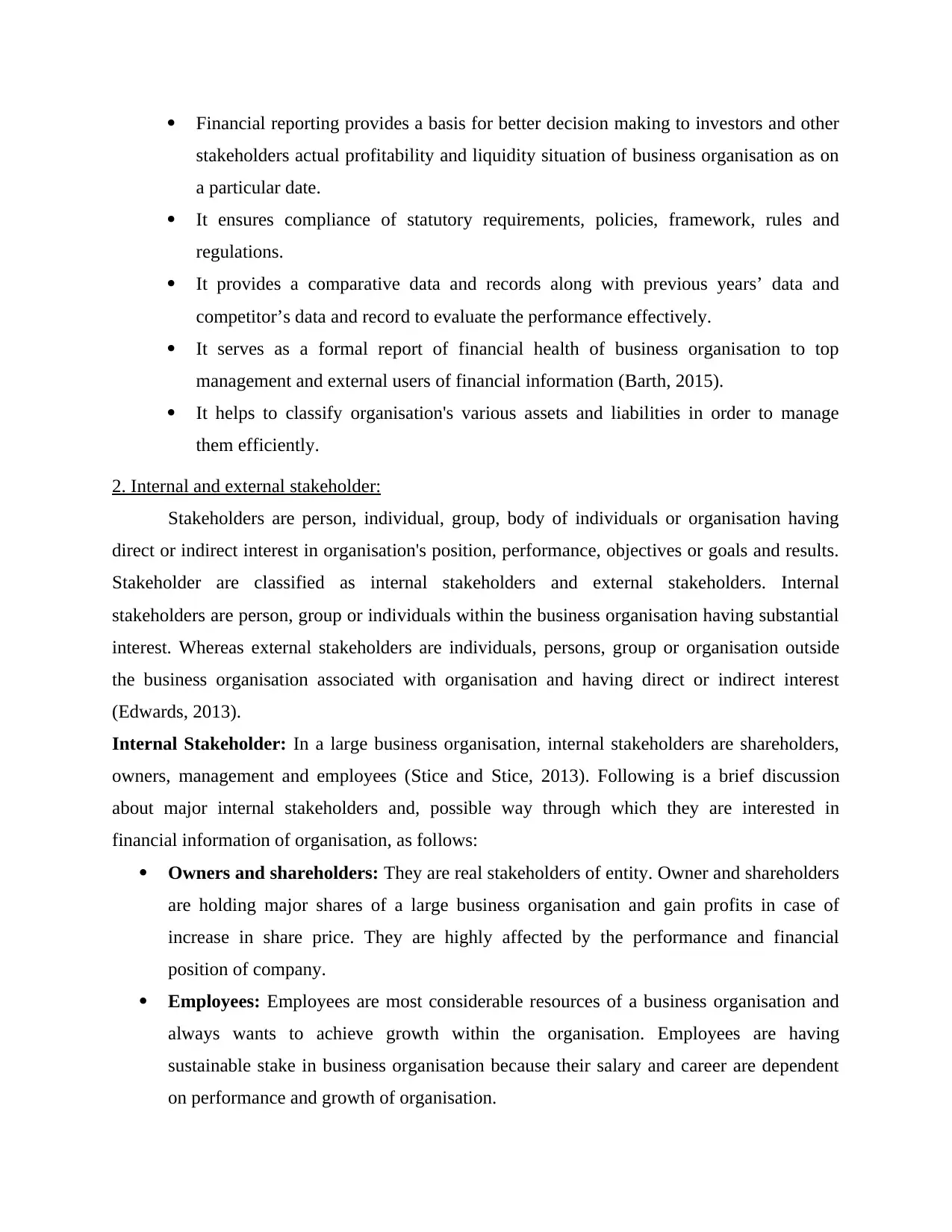
Financial reporting provides a basis for better decision making to investors and other
stakeholders actual profitability and liquidity situation of business organisation as on
a particular date.
It ensures compliance of statutory requirements, policies, framework, rules and
regulations.
It provides a comparative data and records along with previous years’ data and
competitor’s data and record to evaluate the performance effectively.
It serves as a formal report of financial health of business organisation to top
management and external users of financial information (Barth, 2015).
It helps to classify organisation's various assets and liabilities in order to manage
them efficiently.
2. Internal and external stakeholder:
Stakeholders are person, individual, group, body of individuals or organisation having
direct or indirect interest in organisation's position, performance, objectives or goals and results.
Stakeholder are classified as internal stakeholders and external stakeholders. Internal
stakeholders are person, group or individuals within the business organisation having substantial
interest. Whereas external stakeholders are individuals, persons, group or organisation outside
the business organisation associated with organisation and having direct or indirect interest
(Edwards, 2013).
Internal Stakeholder: In a large business organisation, internal stakeholders are shareholders,
owners, management and employees (Stice and Stice, 2013). Following is a brief discussion
about major internal stakeholders and, possible way through which they are interested in
financial information of organisation, as follows:
Owners and shareholders: They are real stakeholders of entity. Owner and shareholders
are holding major shares of a large business organisation and gain profits in case of
increase in share price. They are highly affected by the performance and financial
position of company.
Employees: Employees are most considerable resources of a business organisation and
always wants to achieve growth within the organisation. Employees are having
sustainable stake in business organisation because their salary and career are dependent
on performance and growth of organisation.
stakeholders actual profitability and liquidity situation of business organisation as on
a particular date.
It ensures compliance of statutory requirements, policies, framework, rules and
regulations.
It provides a comparative data and records along with previous years’ data and
competitor’s data and record to evaluate the performance effectively.
It serves as a formal report of financial health of business organisation to top
management and external users of financial information (Barth, 2015).
It helps to classify organisation's various assets and liabilities in order to manage
them efficiently.
2. Internal and external stakeholder:
Stakeholders are person, individual, group, body of individuals or organisation having
direct or indirect interest in organisation's position, performance, objectives or goals and results.
Stakeholder are classified as internal stakeholders and external stakeholders. Internal
stakeholders are person, group or individuals within the business organisation having substantial
interest. Whereas external stakeholders are individuals, persons, group or organisation outside
the business organisation associated with organisation and having direct or indirect interest
(Edwards, 2013).
Internal Stakeholder: In a large business organisation, internal stakeholders are shareholders,
owners, management and employees (Stice and Stice, 2013). Following is a brief discussion
about major internal stakeholders and, possible way through which they are interested in
financial information of organisation, as follows:
Owners and shareholders: They are real stakeholders of entity. Owner and shareholders
are holding major shares of a large business organisation and gain profits in case of
increase in share price. They are highly affected by the performance and financial
position of company.
Employees: Employees are most considerable resources of a business organisation and
always wants to achieve growth within the organisation. Employees are having
sustainable stake in business organisation because their salary and career are dependent
on performance and growth of organisation.
Paraphrase This Document
Need a fresh take? Get an instant paraphrase of this document with our AI Paraphraser
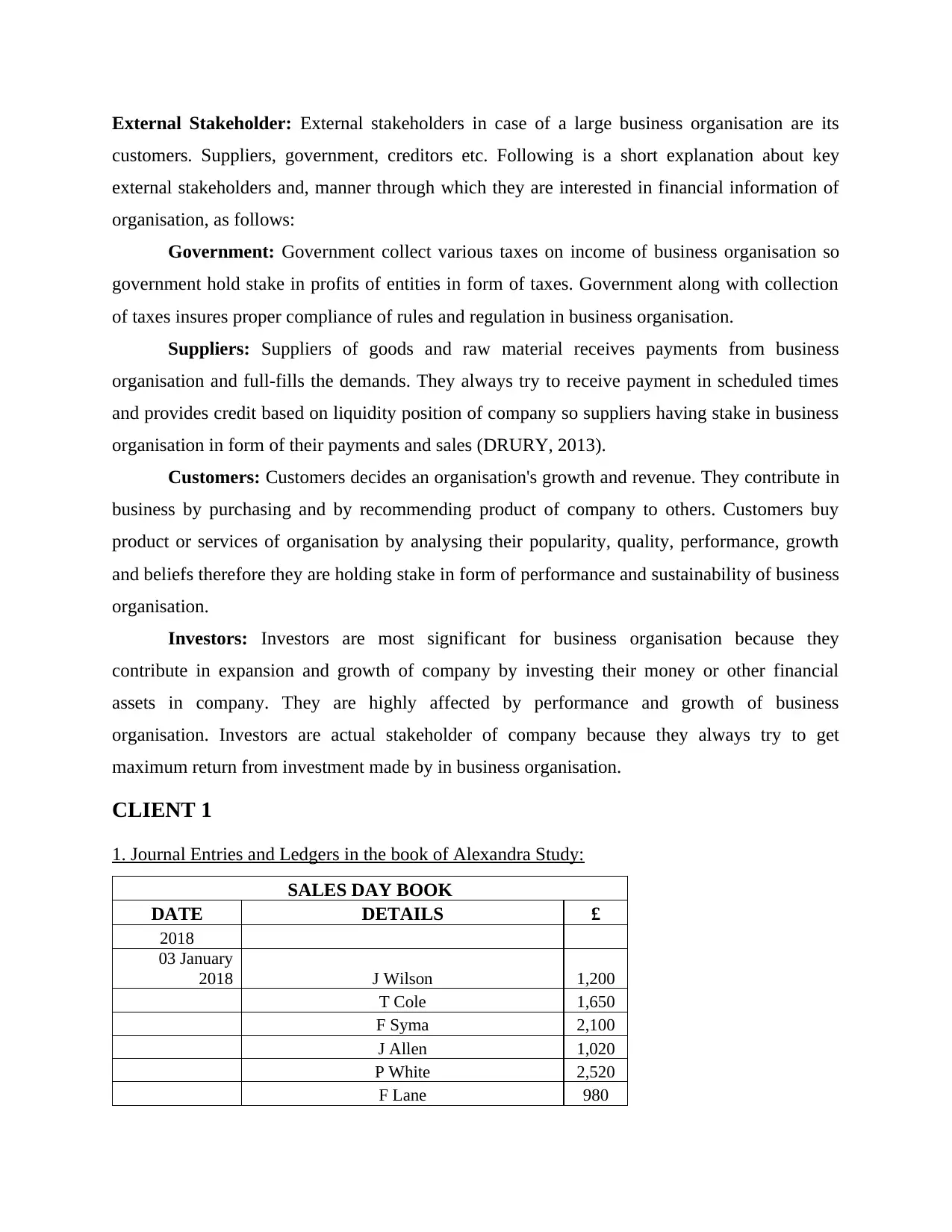
External Stakeholder: External stakeholders in case of a large business organisation are its
customers. Suppliers, government, creditors etc. Following is a short explanation about key
external stakeholders and, manner through which they are interested in financial information of
organisation, as follows:
Government: Government collect various taxes on income of business organisation so
government hold stake in profits of entities in form of taxes. Government along with collection
of taxes insures proper compliance of rules and regulation in business organisation.
Suppliers: Suppliers of goods and raw material receives payments from business
organisation and full-fills the demands. They always try to receive payment in scheduled times
and provides credit based on liquidity position of company so suppliers having stake in business
organisation in form of their payments and sales (DRURY, 2013).
Customers: Customers decides an organisation's growth and revenue. They contribute in
business by purchasing and by recommending product of company to others. Customers buy
product or services of organisation by analysing their popularity, quality, performance, growth
and beliefs therefore they are holding stake in form of performance and sustainability of business
organisation.
Investors: Investors are most significant for business organisation because they
contribute in expansion and growth of company by investing their money or other financial
assets in company. They are highly affected by performance and growth of business
organisation. Investors are actual stakeholder of company because they always try to get
maximum return from investment made by in business organisation.
CLIENT 1
1. Journal Entries and Ledgers in the book of Alexandra Study:
SALES DAY BOOK
DATE DETAILS £
2018
03 January
2018 J Wilson 1,200
T Cole 1,650
F Syma 2,100
J Allen 1,020
P White 2,520
F Lane 980
customers. Suppliers, government, creditors etc. Following is a short explanation about key
external stakeholders and, manner through which they are interested in financial information of
organisation, as follows:
Government: Government collect various taxes on income of business organisation so
government hold stake in profits of entities in form of taxes. Government along with collection
of taxes insures proper compliance of rules and regulation in business organisation.
Suppliers: Suppliers of goods and raw material receives payments from business
organisation and full-fills the demands. They always try to receive payment in scheduled times
and provides credit based on liquidity position of company so suppliers having stake in business
organisation in form of their payments and sales (DRURY, 2013).
Customers: Customers decides an organisation's growth and revenue. They contribute in
business by purchasing and by recommending product of company to others. Customers buy
product or services of organisation by analysing their popularity, quality, performance, growth
and beliefs therefore they are holding stake in form of performance and sustainability of business
organisation.
Investors: Investors are most significant for business organisation because they
contribute in expansion and growth of company by investing their money or other financial
assets in company. They are highly affected by performance and growth of business
organisation. Investors are actual stakeholder of company because they always try to get
maximum return from investment made by in business organisation.
CLIENT 1
1. Journal Entries and Ledgers in the book of Alexandra Study:
SALES DAY BOOK
DATE DETAILS £
2018
03 January
2018 J Wilson 1,200
T Cole 1,650
F Syma 2,100
J Allen 1,020
P White 2,520
F Lane 980
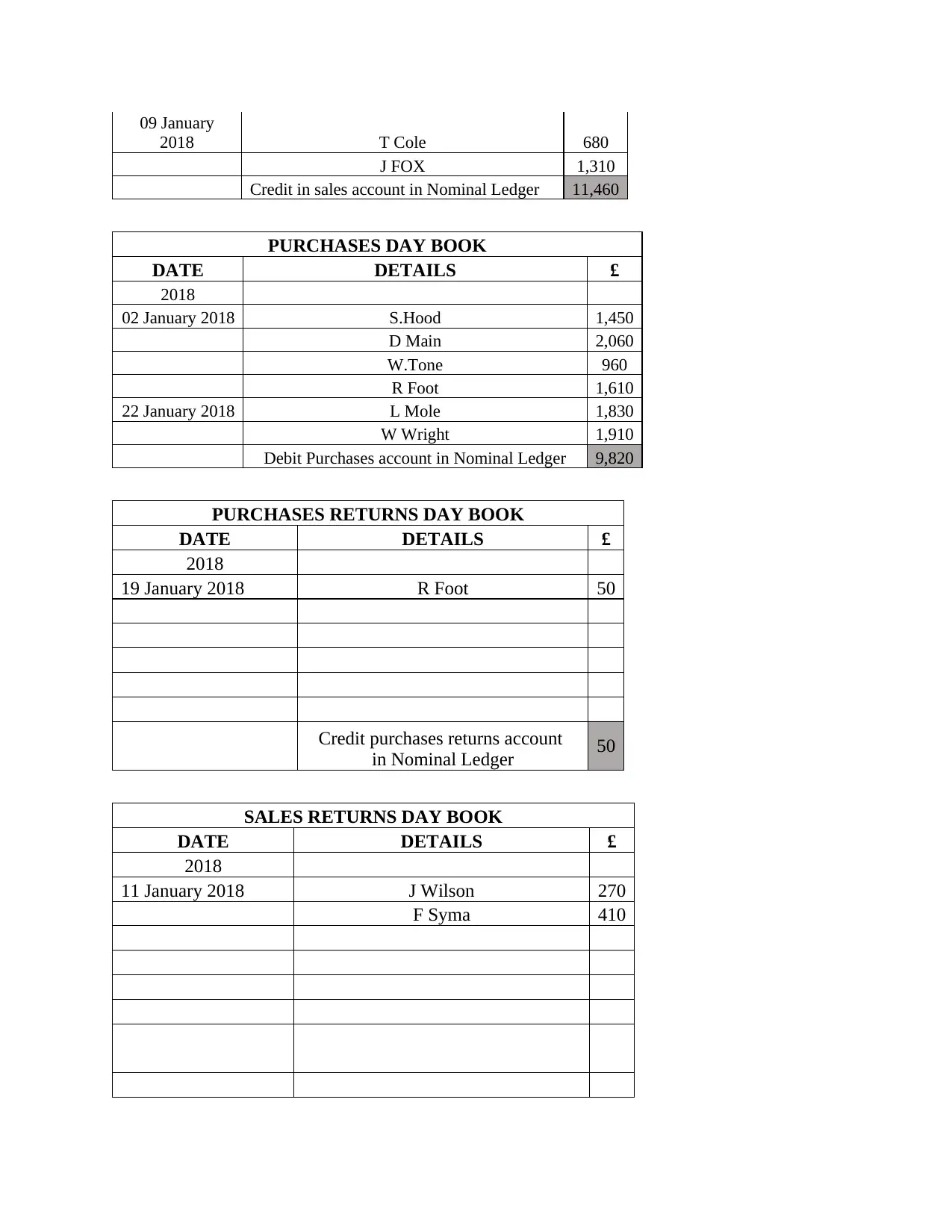
09 January
2018 T Cole 680
J FOX 1,310
Credit in sales account in Nominal Ledger 11,460
PURCHASES DAY BOOK
DATE DETAILS £
2018
02 January 2018 S.Hood 1,450
D Main 2,060
W.Tone 960
R Foot 1,610
22 January 2018 L Mole 1,830
W Wright 1,910
Debit Purchases account in Nominal Ledger 9,820
PURCHASES RETURNS DAY BOOK
DATE DETAILS £
2018
19 January 2018 R Foot 50
Credit purchases returns account
in Nominal Ledger 50
SALES RETURNS DAY BOOK
DATE DETAILS £
2018
11 January 2018 J Wilson 270
F Syma 410
2018 T Cole 680
J FOX 1,310
Credit in sales account in Nominal Ledger 11,460
PURCHASES DAY BOOK
DATE DETAILS £
2018
02 January 2018 S.Hood 1,450
D Main 2,060
W.Tone 960
R Foot 1,610
22 January 2018 L Mole 1,830
W Wright 1,910
Debit Purchases account in Nominal Ledger 9,820
PURCHASES RETURNS DAY BOOK
DATE DETAILS £
2018
19 January 2018 R Foot 50
Credit purchases returns account
in Nominal Ledger 50
SALES RETURNS DAY BOOK
DATE DETAILS £
2018
11 January 2018 J Wilson 270
F Syma 410
⊘ This is a preview!⊘
Do you want full access?
Subscribe today to unlock all pages.

Trusted by 1+ million students worldwide
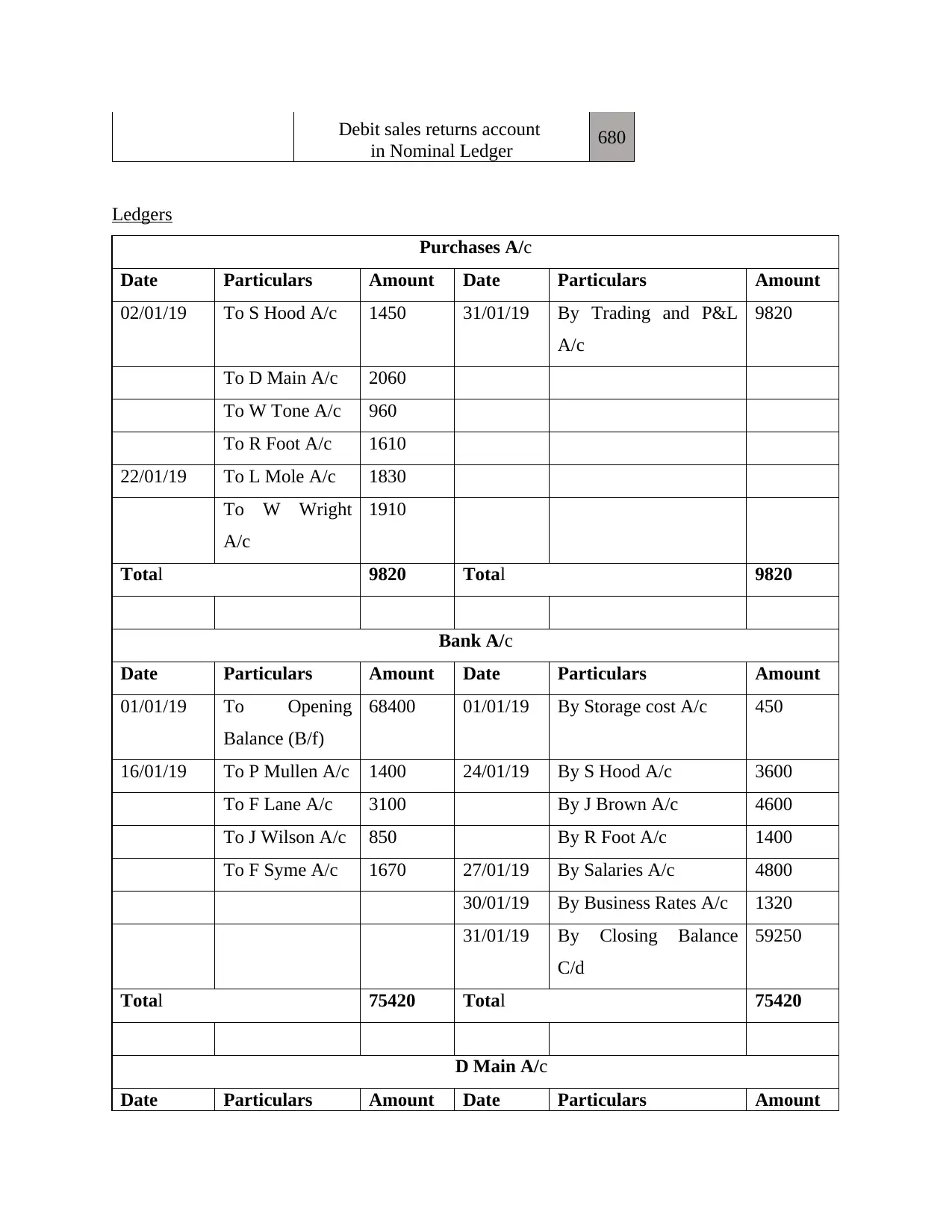
Debit sales returns account
in Nominal Ledger 680
Ledgers
Purchases A/c
Date Particulars Amount Date Particulars Amount
02/01/19 To S Hood A/c 1450 31/01/19 By Trading and P&L
A/c
9820
To D Main A/c 2060
To W Tone A/c 960
To R Foot A/c 1610
22/01/19 To L Mole A/c 1830
To W Wright
A/c
1910
Total 9820 Total 9820
Bank A/c
Date Particulars Amount Date Particulars Amount
01/01/19 To Opening
Balance (B/f)
68400 01/01/19 By Storage cost A/c 450
16/01/19 To P Mullen A/c 1400 24/01/19 By S Hood A/c 3600
To F Lane A/c 3100 By J Brown A/c 4600
To J Wilson A/c 850 By R Foot A/c 1400
To F Syme A/c 1670 27/01/19 By Salaries A/c 4800
30/01/19 By Business Rates A/c 1320
31/01/19 By Closing Balance
C/d
59250
Total 75420 Total 75420
D Main A/c
Date Particulars Amount Date Particulars Amount
in Nominal Ledger 680
Ledgers
Purchases A/c
Date Particulars Amount Date Particulars Amount
02/01/19 To S Hood A/c 1450 31/01/19 By Trading and P&L
A/c
9820
To D Main A/c 2060
To W Tone A/c 960
To R Foot A/c 1610
22/01/19 To L Mole A/c 1830
To W Wright
A/c
1910
Total 9820 Total 9820
Bank A/c
Date Particulars Amount Date Particulars Amount
01/01/19 To Opening
Balance (B/f)
68400 01/01/19 By Storage cost A/c 450
16/01/19 To P Mullen A/c 1400 24/01/19 By S Hood A/c 3600
To F Lane A/c 3100 By J Brown A/c 4600
To J Wilson A/c 850 By R Foot A/c 1400
To F Syme A/c 1670 27/01/19 By Salaries A/c 4800
30/01/19 By Business Rates A/c 1320
31/01/19 By Closing Balance
C/d
59250
Total 75420 Total 75420
D Main A/c
Date Particulars Amount Date Particulars Amount
Paraphrase This Document
Need a fresh take? Get an instant paraphrase of this document with our AI Paraphraser
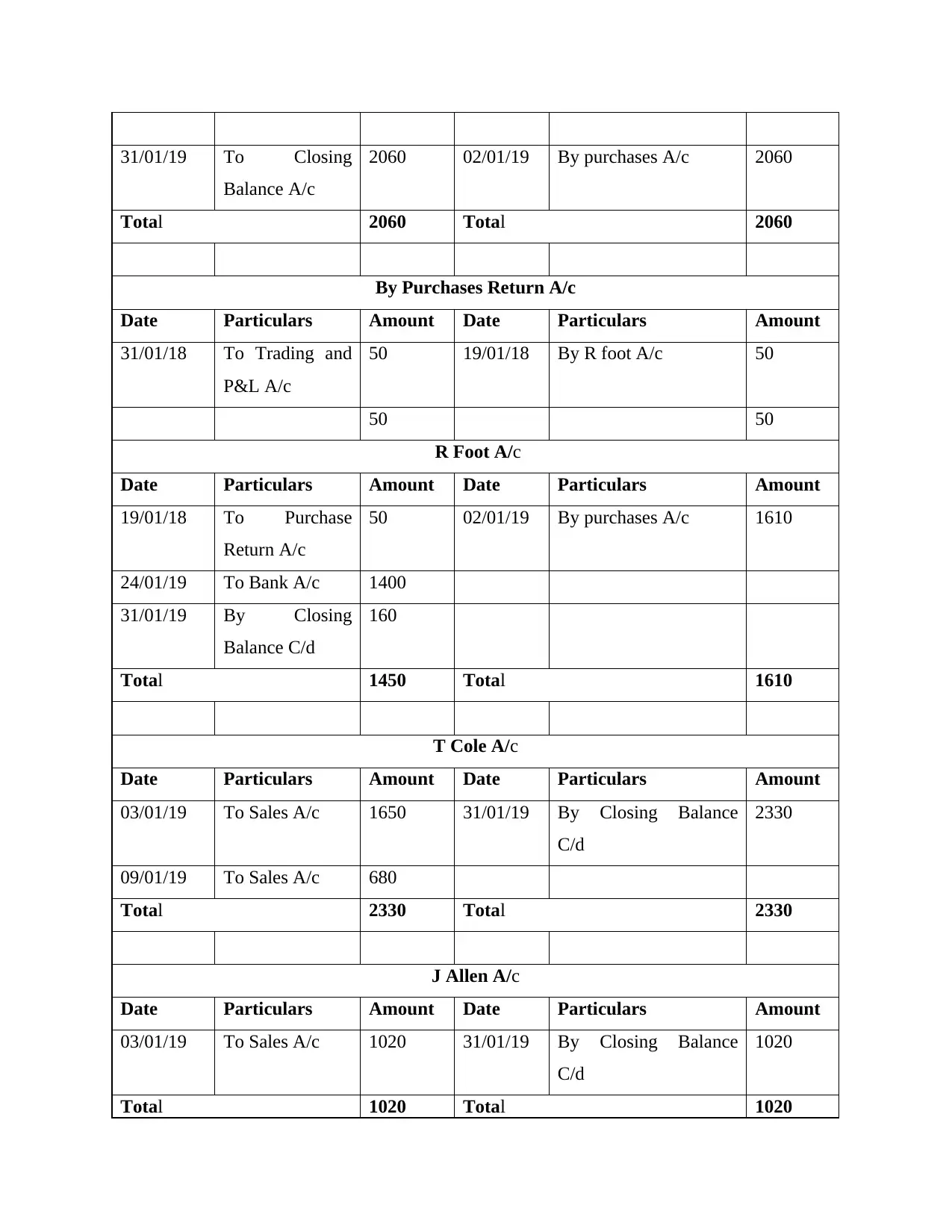
31/01/19 To Closing
Balance A/c
2060 02/01/19 By purchases A/c 2060
Total 2060 Total 2060
By Purchases Return A/c
Date Particulars Amount Date Particulars Amount
31/01/18 To Trading and
P&L A/c
50 19/01/18 By R foot A/c 50
50 50
R Foot A/c
Date Particulars Amount Date Particulars Amount
19/01/18 To Purchase
Return A/c
50 02/01/19 By purchases A/c 1610
24/01/19 To Bank A/c 1400
31/01/19 By Closing
Balance C/d
160
Total 1450 Total 1610
T Cole A/c
Date Particulars Amount Date Particulars Amount
03/01/19 To Sales A/c 1650 31/01/19 By Closing Balance
C/d
2330
09/01/19 To Sales A/c 680
Total 2330 Total 2330
J Allen A/c
Date Particulars Amount Date Particulars Amount
03/01/19 To Sales A/c 1020 31/01/19 By Closing Balance
C/d
1020
Total 1020 Total 1020
Balance A/c
2060 02/01/19 By purchases A/c 2060
Total 2060 Total 2060
By Purchases Return A/c
Date Particulars Amount Date Particulars Amount
31/01/18 To Trading and
P&L A/c
50 19/01/18 By R foot A/c 50
50 50
R Foot A/c
Date Particulars Amount Date Particulars Amount
19/01/18 To Purchase
Return A/c
50 02/01/19 By purchases A/c 1610
24/01/19 To Bank A/c 1400
31/01/19 By Closing
Balance C/d
160
Total 1450 Total 1610
T Cole A/c
Date Particulars Amount Date Particulars Amount
03/01/19 To Sales A/c 1650 31/01/19 By Closing Balance
C/d
2330
09/01/19 To Sales A/c 680
Total 2330 Total 2330
J Allen A/c
Date Particulars Amount Date Particulars Amount
03/01/19 To Sales A/c 1020 31/01/19 By Closing Balance
C/d
1020
Total 1020 Total 1020
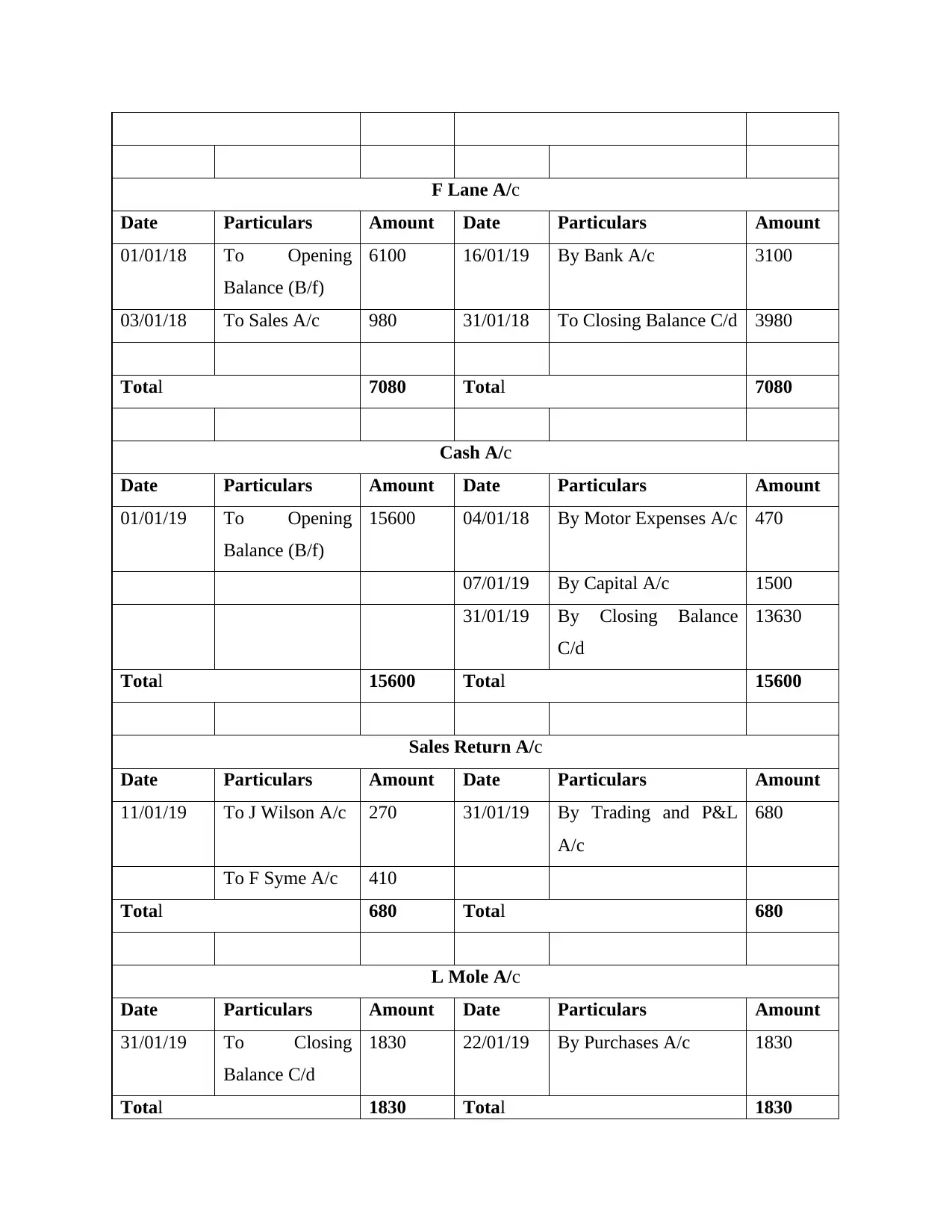
F Lane A/c
Date Particulars Amount Date Particulars Amount
01/01/18 To Opening
Balance (B/f)
6100 16/01/19 By Bank A/c 3100
03/01/18 To Sales A/c 980 31/01/18 To Closing Balance C/d 3980
Total 7080 Total 7080
Cash A/c
Date Particulars Amount Date Particulars Amount
01/01/19 To Opening
Balance (B/f)
15600 04/01/18 By Motor Expenses A/c 470
07/01/19 By Capital A/c 1500
31/01/19 By Closing Balance
C/d
13630
Total 15600 Total 15600
Sales Return A/c
Date Particulars Amount Date Particulars Amount
11/01/19 To J Wilson A/c 270 31/01/19 By Trading and P&L
A/c
680
To F Syme A/c 410
Total 680 Total 680
L Mole A/c
Date Particulars Amount Date Particulars Amount
31/01/19 To Closing
Balance C/d
1830 22/01/19 By Purchases A/c 1830
Total 1830 Total 1830
Date Particulars Amount Date Particulars Amount
01/01/18 To Opening
Balance (B/f)
6100 16/01/19 By Bank A/c 3100
03/01/18 To Sales A/c 980 31/01/18 To Closing Balance C/d 3980
Total 7080 Total 7080
Cash A/c
Date Particulars Amount Date Particulars Amount
01/01/19 To Opening
Balance (B/f)
15600 04/01/18 By Motor Expenses A/c 470
07/01/19 By Capital A/c 1500
31/01/19 By Closing Balance
C/d
13630
Total 15600 Total 15600
Sales Return A/c
Date Particulars Amount Date Particulars Amount
11/01/19 To J Wilson A/c 270 31/01/19 By Trading and P&L
A/c
680
To F Syme A/c 410
Total 680 Total 680
L Mole A/c
Date Particulars Amount Date Particulars Amount
31/01/19 To Closing
Balance C/d
1830 22/01/19 By Purchases A/c 1830
Total 1830 Total 1830
⊘ This is a preview!⊘
Do you want full access?
Subscribe today to unlock all pages.

Trusted by 1+ million students worldwide
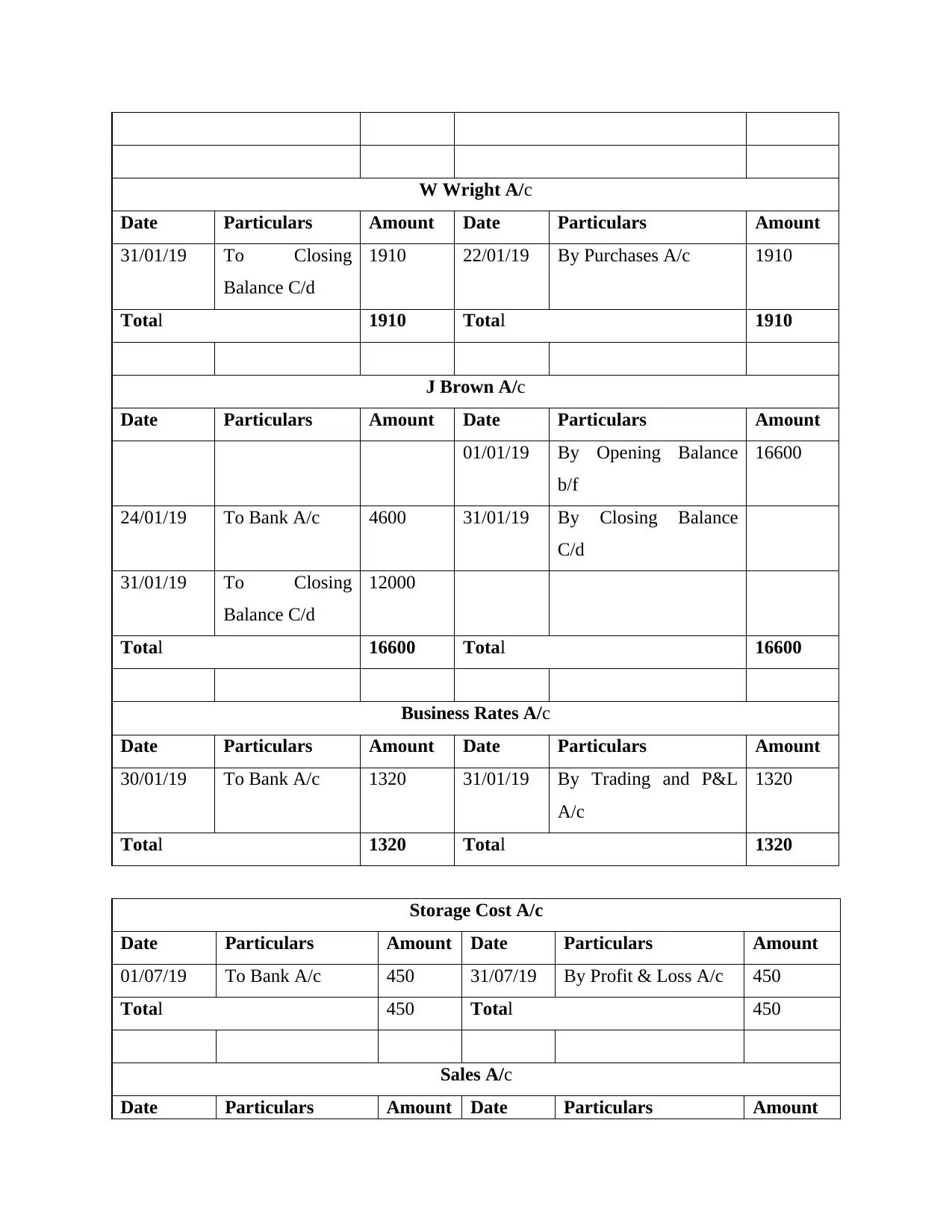
W Wright A/c
Date Particulars Amount Date Particulars Amount
31/01/19 To Closing
Balance C/d
1910 22/01/19 By Purchases A/c 1910
Total 1910 Total 1910
J Brown A/c
Date Particulars Amount Date Particulars Amount
01/01/19 By Opening Balance
b/f
16600
24/01/19 To Bank A/c 4600 31/01/19 By Closing Balance
C/d
31/01/19 To Closing
Balance C/d
12000
Total 16600 Total 16600
Business Rates A/c
Date Particulars Amount Date Particulars Amount
30/01/19 To Bank A/c 1320 31/01/19 By Trading and P&L
A/c
1320
Total 1320 Total 1320
Storage Cost A/c
Date Particulars Amount Date Particulars Amount
01/07/19 To Bank A/c 450 31/07/19 By Profit & Loss A/c 450
Total 450 Total 450
Sales A/c
Date Particulars Amount Date Particulars Amount
Date Particulars Amount Date Particulars Amount
31/01/19 To Closing
Balance C/d
1910 22/01/19 By Purchases A/c 1910
Total 1910 Total 1910
J Brown A/c
Date Particulars Amount Date Particulars Amount
01/01/19 By Opening Balance
b/f
16600
24/01/19 To Bank A/c 4600 31/01/19 By Closing Balance
C/d
31/01/19 To Closing
Balance C/d
12000
Total 16600 Total 16600
Business Rates A/c
Date Particulars Amount Date Particulars Amount
30/01/19 To Bank A/c 1320 31/01/19 By Trading and P&L
A/c
1320
Total 1320 Total 1320
Storage Cost A/c
Date Particulars Amount Date Particulars Amount
01/07/19 To Bank A/c 450 31/07/19 By Profit & Loss A/c 450
Total 450 Total 450
Sales A/c
Date Particulars Amount Date Particulars Amount
Paraphrase This Document
Need a fresh take? Get an instant paraphrase of this document with our AI Paraphraser
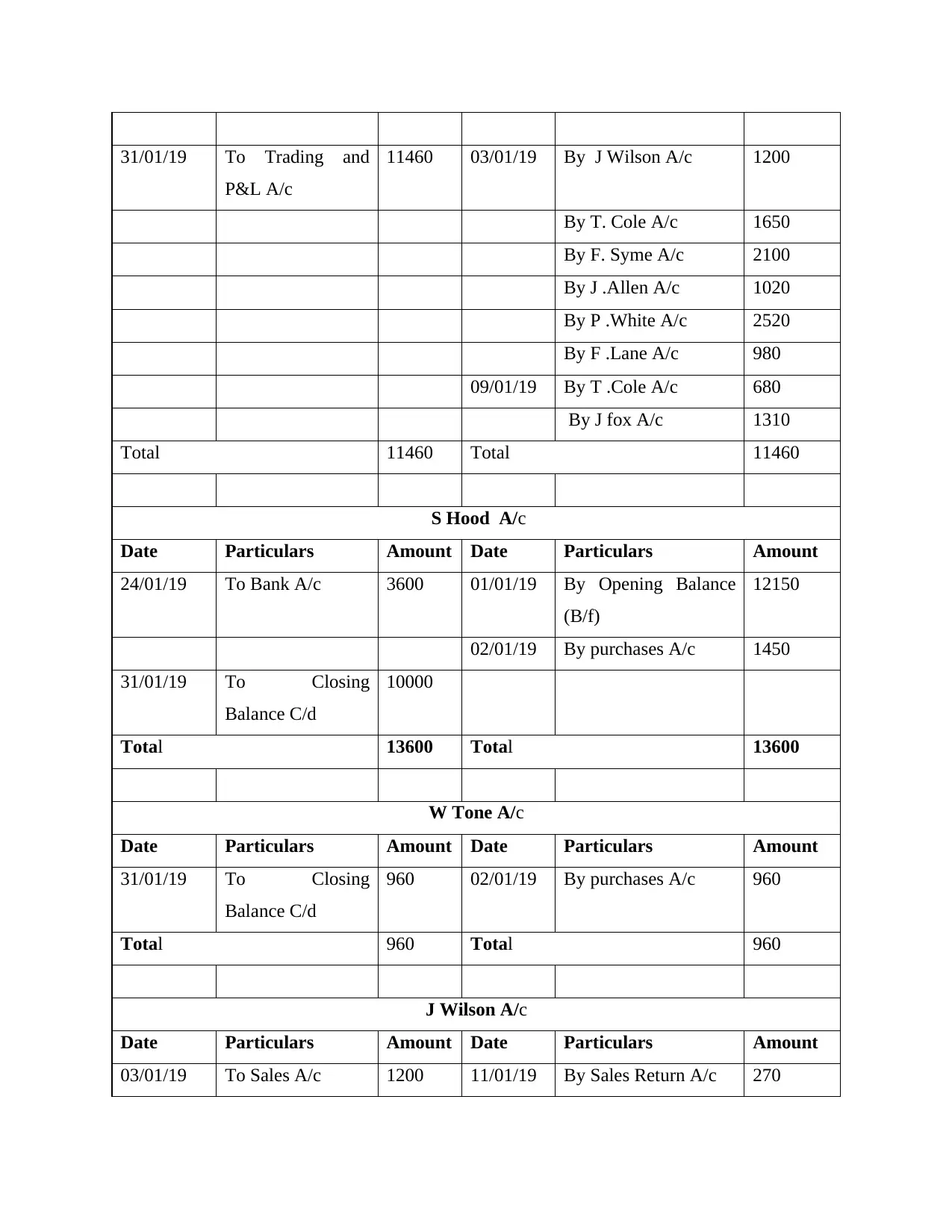
31/01/19 To Trading and
P&L A/c
11460 03/01/19 By J Wilson A/c 1200
By T. Cole A/c 1650
By F. Syme A/c 2100
By J .Allen A/c 1020
By P .White A/c 2520
By F .Lane A/c 980
09/01/19 By T .Cole A/c 680
By J fox A/c 1310
Total 11460 Total 11460
S Hood A/c
Date Particulars Amount Date Particulars Amount
24/01/19 To Bank A/c 3600 01/01/19 By Opening Balance
(B/f)
12150
02/01/19 By purchases A/c 1450
31/01/19 To Closing
Balance C/d
10000
Total 13600 Total 13600
W Tone A/c
Date Particulars Amount Date Particulars Amount
31/01/19 To Closing
Balance C/d
960 02/01/19 By purchases A/c 960
Total 960 Total 960
J Wilson A/c
Date Particulars Amount Date Particulars Amount
03/01/19 To Sales A/c 1200 11/01/19 By Sales Return A/c 270
P&L A/c
11460 03/01/19 By J Wilson A/c 1200
By T. Cole A/c 1650
By F. Syme A/c 2100
By J .Allen A/c 1020
By P .White A/c 2520
By F .Lane A/c 980
09/01/19 By T .Cole A/c 680
By J fox A/c 1310
Total 11460 Total 11460
S Hood A/c
Date Particulars Amount Date Particulars Amount
24/01/19 To Bank A/c 3600 01/01/19 By Opening Balance
(B/f)
12150
02/01/19 By purchases A/c 1450
31/01/19 To Closing
Balance C/d
10000
Total 13600 Total 13600
W Tone A/c
Date Particulars Amount Date Particulars Amount
31/01/19 To Closing
Balance C/d
960 02/01/19 By purchases A/c 960
Total 960 Total 960
J Wilson A/c
Date Particulars Amount Date Particulars Amount
03/01/19 To Sales A/c 1200 11/01/19 By Sales Return A/c 270
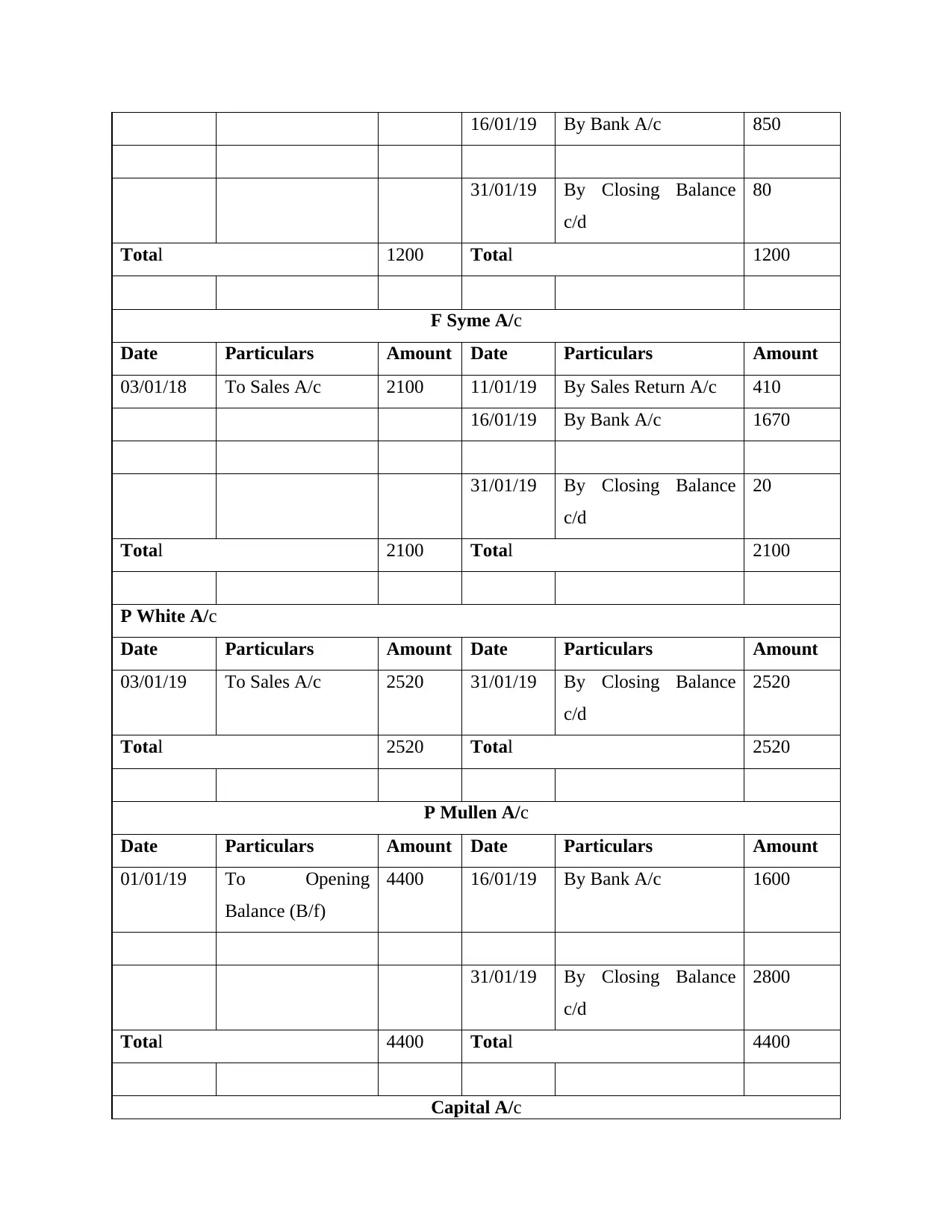
16/01/19 By Bank A/c 850
31/01/19 By Closing Balance
c/d
80
Total 1200 Total 1200
F Syme A/c
Date Particulars Amount Date Particulars Amount
03/01/18 To Sales A/c 2100 11/01/19 By Sales Return A/c 410
16/01/19 By Bank A/c 1670
31/01/19 By Closing Balance
c/d
20
Total 2100 Total 2100
P White A/c
Date Particulars Amount Date Particulars Amount
03/01/19 To Sales A/c 2520 31/01/19 By Closing Balance
c/d
2520
Total 2520 Total 2520
P Mullen A/c
Date Particulars Amount Date Particulars Amount
01/01/19 To Opening
Balance (B/f)
4400 16/01/19 By Bank A/c 1600
31/01/19 By Closing Balance
c/d
2800
Total 4400 Total 4400
Capital A/c
31/01/19 By Closing Balance
c/d
80
Total 1200 Total 1200
F Syme A/c
Date Particulars Amount Date Particulars Amount
03/01/18 To Sales A/c 2100 11/01/19 By Sales Return A/c 410
16/01/19 By Bank A/c 1670
31/01/19 By Closing Balance
c/d
20
Total 2100 Total 2100
P White A/c
Date Particulars Amount Date Particulars Amount
03/01/19 To Sales A/c 2520 31/01/19 By Closing Balance
c/d
2520
Total 2520 Total 2520
P Mullen A/c
Date Particulars Amount Date Particulars Amount
01/01/19 To Opening
Balance (B/f)
4400 16/01/19 By Bank A/c 1600
31/01/19 By Closing Balance
c/d
2800
Total 4400 Total 4400
Capital A/c
⊘ This is a preview!⊘
Do you want full access?
Subscribe today to unlock all pages.

Trusted by 1+ million students worldwide
1 out of 21
Related Documents
Your All-in-One AI-Powered Toolkit for Academic Success.
+13062052269
info@desklib.com
Available 24*7 on WhatsApp / Email
![[object Object]](/_next/static/media/star-bottom.7253800d.svg)
Unlock your academic potential
Copyright © 2020–2025 A2Z Services. All Rights Reserved. Developed and managed by ZUCOL.





